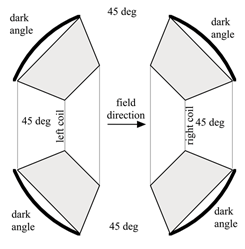
|
MA7 |
|

SINQ LIN LIN
SINQ Wiki
This Page
Referenced by
Wiki Info
JSPWiki v2.0.52
|
|
This is version 29.
It is not the current version, and thus it cannot be edited. 6.8 Tesla Horizontal Field Cryomagnet MA7
The horizontal high field cryomagnet has a restricted neutron access. There are 4 windows of 45 deg each, valid for a sample of 15 mm diameter.
For access with polarized neutrons, an asymmetric mode (max. 6.2 Tesla) is available. This is needed when a beam perpendicular to the field is used. This cryomagnet has strong stray fields due to the size of its coils. Before it may be used on any instrument, force tests have to be done. The specifications allow forces up to 1000 N vertically and 500 N horizontally.
Restrictions on RITA-IIProvisional force measuremnents on RITA-II have shown that the operation of MA7 on Rita-II is allowed:
For any other configuration force tests have to be done. As soon as the approriate adapter plate is avaliable, we should repeat the force measurements. Original data:
Restrictions on AMORProvisional force measuremnents on AMOR have shown that the operation of MA7 on AMOR is allowed with a field perpendicular to the beam at least up to 4 Tesla. The distance to the shielding wall between AMOR and SANS-II has to be at least 540 mm, measured from the aluminium window (or about 870 mm to the magnet centre). Torque Calculations In general, the forces are not only radial, but also tangential, inducing a torque onto the magnet. For estimating the forces on the fixation, we need to take into account the distance of the fixation points from the coil center. For MA7, with a mean coil radius of about 100 m and fixation points at about 150 mm for the coil center, we get the following:
Ro: object distance (mm)
For the distance to the shielding wall we have to add 1/5 of the edge distance for the mean distance of the material that has to be taken into account (870 * 6/5 = 1044 mm).
Measured force at 3.4 Tesla: 180 N.
Restrictions on TASP
Attachments: asysym.jpg MA7pict.jpg MA7coils.png P3010088.JPG This particular version was published on 02-Mar-2011 09:14:24 UTC by StephanFischer. |


